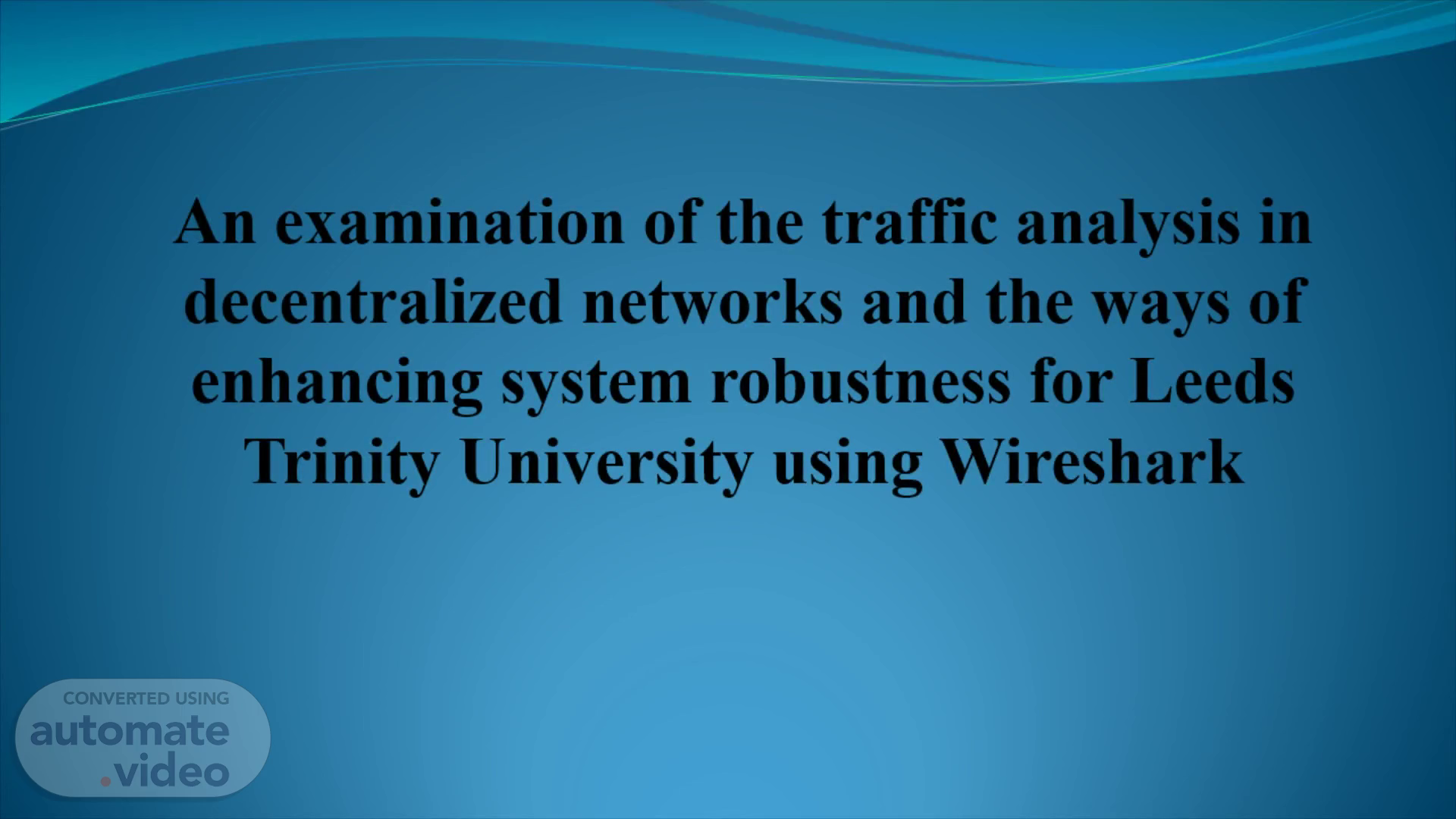
Title of the Research
Scene 1 (0s)
An examination of the traffic analysis in decentralized networks and the ways of enhancing system robustness for Leeds Trinity University using Wireshark.
Scene 2 (9s)
Introduction. Traffic investigation can be used for the malicious determination and can also be used to inspect the materials of the broadcasted data such as file names, passwords, and the talking Parties. The main issue here is to identify the traffic which is not authenticated. For this reason, Wireshark will be used to analyze the traffic volume in this university server. The main outcome will be a clear picture about the traffic type that use the university server..
Scene 3 (32s)
Aim and objectives. The main aim of this project is to examine the network traffic of the mentioned university using Wireshark Objective Identification of total network traffic for decentralized network To explore the malicious activity using Wireshark..
Scene 4 (46s)
Problems to be solved. Trouble shooting systems communication Network traffic analysis Administration of network system Reporting suspicious activities of any specific traffic..
Scene 5 (56s)
Literature. As mentioned by Of Yoon et al.(2021), ICMP is used for disruption and monitoring, and alerting to signify the data comes out on a well-timed basis with the desired terminals. As this reserch also focusing on analysis the server details. The most important things found in the research paper of Chen, as he mentioned that the server and client have commenced a TCP assembly. However, most of existing work focuses on cyber security prospective, but here the main focus is identifying some specigic traffic which are susp•sus..
Scene 6 (1m 21s)
Data and Approach to collect data. Primary data Secondary data.
Scene 7 (1m 31s)
Ethical and Practical Consideration. Ethical considerations in the investigation that are supposed to set of assumptions . That lead the way to the user's investigation blueprints and implementation. The assumptions. Influence informed consent, voluntary participation, confidentiality, anonymity, the potential for loss, and results from communication (Chen et al. 2020)..
Scene 8 (1m 48s)
Proposed method. Cap IRESHARK is. abstract. This is a sample table taken from https://www.wireshark.org/docs/wsug_html/ ).
Scene 9 (2m 1s)
Proposed method. This is a sample type of Network diagram of this university. This has been assumed here in order to make the project proposal. The traffic data will be taken from this type of real-time network..
Scene 10 (2m 17s)
Results Analysis and Evaluation. Filters Description src 192.168.1.1 and tcp port 21 All traffic originating from 192.168.1.1 and associated with port 21 host 192.168.1.1 All traffic associated with host 192.168.1.1 not port 80 All traffic not associated with port 80 dst 192.168.1.1 or dst 192.168.1.2 All traffic destined to 192.168.1.1 or destined to host 192.168.1.2 port 8080 All traffic associated with port 8080.
Scene 11 (2m 45s)
Planning the Research. Firstly, Background research will be preformed to collect the data. Depending on data collection, traffic analysis has done with the help of Wireshark. After packet analysis, result will be represented..
Scene 12 (2m 59s)
Reference list. Ageyev , D., Radivilova , T., Mulesa , O., Bondarenko , O. And mohammed , O., 2022. Traffic monitoring and abnormality detection methods for decentralized distributed networks. In information security technologies in the decentralized distributed networks (pp. 287-305). Springer, cham . Chow, a.H ., Sha , R. And li , S., 2020. Centralised and decentralised signal timing optimisation approaches for network traffic control. Transportation research part C: emerging technologies, 113, pp.108-123. Chen, c., Wei, H., Xu, N., Zheng , G., Yang, M., Xiong , Y., Xu, K. And li , Z., 2020, april . Toward a thousand lights: decentralized deep reinforcement learning for large-scale traffic signal control. In proceedings of the AAAI conference on artificial intelligence (vol. 34, no. 04, pp. 3414-3421). Manolis , d., Pappa , T., Diakaki , C., Papamichail , I. And papageorgiou , M., 2018. Centralised versus decentralised signal control of large‐scale urban road networks in real time: a simulation study. IET intelligent transport systems, 12(8), pp.891-900..